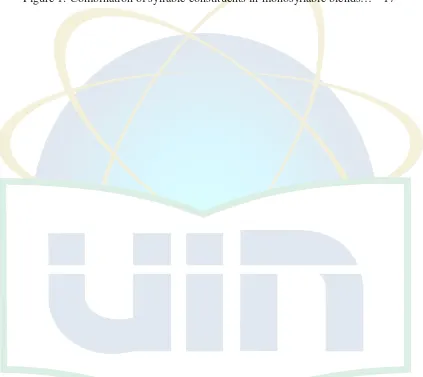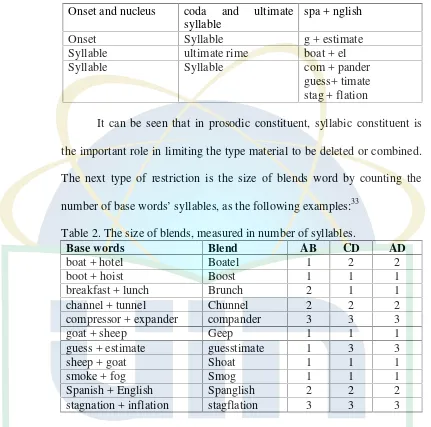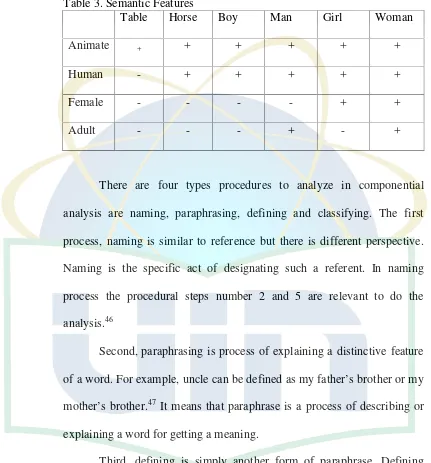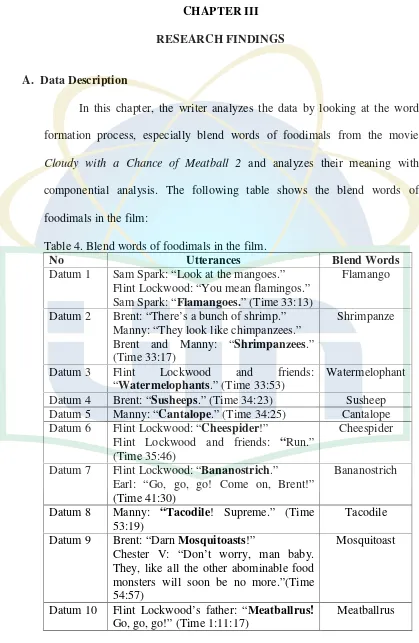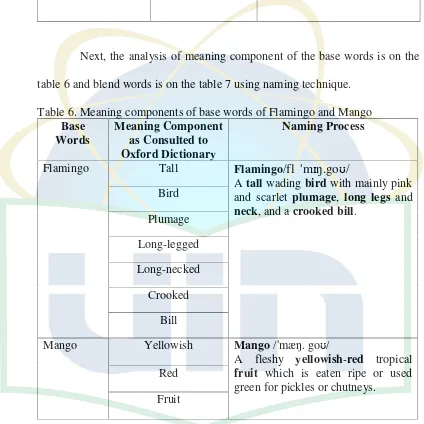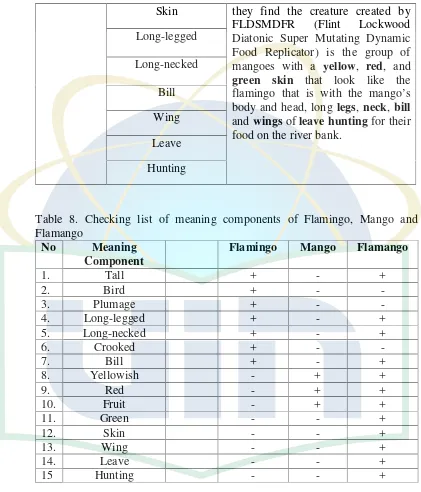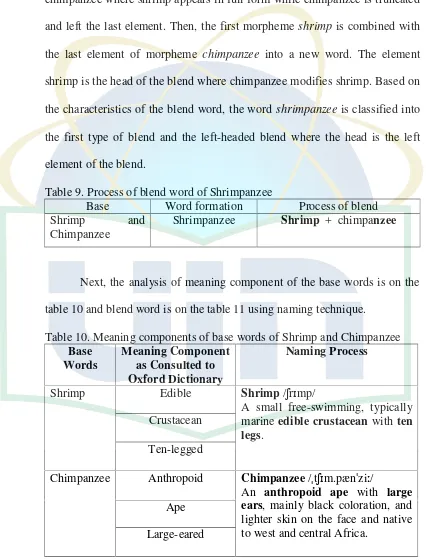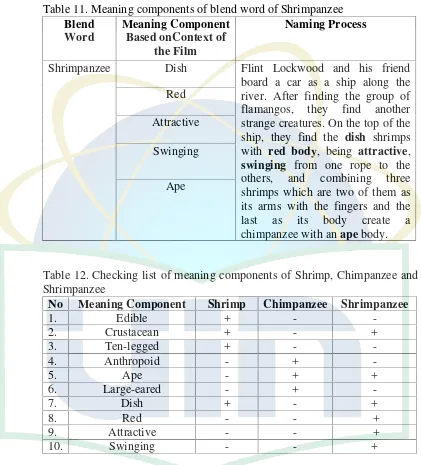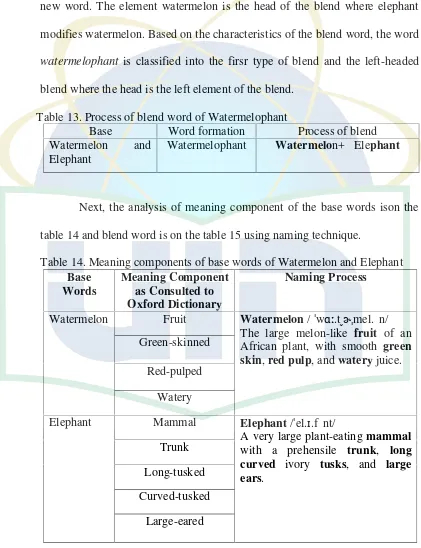i
ABSTRACT
Desi Hasni Asis.
An Analysis of Blend words and Componential Analysis of
“
Foodimals
”
in the Movie Cloudy with a Chance of Meatballs 2.
Thesis: English
Letters Department, Letters and Humanities Faculty, State Islamic University
Syarif Hidayatullah, Jakarta 2014.
This research is aimed to analyze the word formation process of blend
words, component meaning and the meaning of foodimals based on context in
Cloudy with a Chance of Meatballs 2
film. The method used in this research is
descriptive qualitative. The method of descriptive qualitative used by the writer
is content analysis. To analyze the word formation process of blend the writer
uses Ingo Plag’s theory and componential analysis by Eugene A. Nida with
naming technique.
After analyzing the data, the writer concludes that the blend words of
foodimals use first class of blend. Two of the blend words of foodimals are
right-headed while eight of the blend words of foodimals are left-headed.
iv
knowledge and belief, it contains no material previously published or written by
another person nor material which to a substantial extent has been accepted for the
award of any other degree or diploma of the university or other institute of higher
learning, except where due acknowledgment has been made in the text.
Jakarta, December 2014
v
ACKNOWLEDGEMENT
First and foremost, the writer like to thank Allah SWT, the lord of the
world for giving her the best guidance, brightest lights and deepest mercy. The
pour of blessing lead her to finish this thesis.
Shalawat
and
Salam
always devoted
to our Prophet Muhammad, peace be upon him, who has guided us from the
darkness to enlightenment in the world.
The writer would like to express my gratitude for my advisors Sholikatus
Sa’diyah, M.Pd. and Rima Muryantina, S.Hum.,M.Ling.
who always give
inspirations, encouragements, critiques, and sincere guidance for me to finish the
thesis. The writer also would like to take this opportunity for expressing my deep
and sincere gratitude and thankfulness to:
1. Prof. Dr. Oman Fathurahman, M.Hum., The Dean of Faculty of Letters and
Humanities.
2. Drs. A. Saefudin, M.Pd, the Head of English Letters Department.
3. Mrs. Elve Oktafiyani, M.Hum, the Secretary of English LettersDepartment.
4. All of the lecturers in English Letters Department for their valuable
knowledge.
5. All the librarians of Adab and Humanities Faculty and State
IslamicUniversity.
6. My beloved parents: Hajidin and Dodoh for their limitless support, pray and
endless love.
vi
writing my thesis.
Finally, the writer realizes that this thesis is not perfect, that is why the
writer welcomes to receive the critic and suggestion for this thesis to be better.
The writer hopes this thesis will be useful, particularly for the writer and for those
who interested in this field.
Jakarta, December 2014
vii
THE LIST OF TABLES
Table 1: Combination of Syllabic Constituents in Polysyllabic Blends….
17
Table 2: The Size of Blends, Measured in Number of Syllables…………
18
Table 3: Semantic Features……….
22
Table 4: Blend Words of Foodimals on the
Film………...
27
Table 5: Process of Blend Word of Flamango………....
29
Table 6: Meaning Components of Base Words of Flamingo and Mango..
29
Table 7: Meaning Components of Blend Word of Flamango…………....
29
Table 8: Checking List of Meaning Component of Flamingo, Mango and
Flamango………
30
Table 9: Process of Blend Word of Shrimpanzee………...
32
Table 10: Meaning Components of Base Words of Shrimp and
Chimpanzee………....
32
Table 11: Meaning Components of
Blend Word of Shirmpanzee……….
33
Table 12: Checking List of Meaning Component of Shrimp, Chimpanzee
and Shrimpanzee………. 33
Table 13: Process of Blend Word of Watermelophant………...
35
Table 14: Meaning Components of Base Words of Watermelon and
Elephant………..
35
Table 15: Meaning Components of Blend Word of Watermelophant……
36
Table 16: Checking List of Meaning Component of Watermelon,
viii
Table 20: Checking List of Meaning Component of Sushi, Sheep and
Susheep………...
39
Table 21: Process of Blend Word of Cantelope……….
41
Table 22: Meaning Components of Base Words of Cantaloupe and
Antelope………..
41
Table 23: Meaning Components of Blend Word of Cantelope…………..
42
Table 24: Checking List of Meaning Component of Cantaloupe,
Antelope and Cantelope……….. 42
Table 25: Process of Blend Word of Cheespider………
44
Table 26: Meaning Components of Base Words of Cheeseburger and
Spider………..
44
Table 27: Meaning Components of Blend Word of Cheespider……...
45
Table 28: Checking List of Meaning Component of Cheeseburger,
Spider and Cheespider………
45
Table 29: Process of Blend Word of
Bananostrich………
47
Table 30: Meaning Components of Base Words of Banana and Ostrich...
47
Table 31: Meaning Components of Blend Word of Bananostrich……….
48
Table 32: Checking List of Meaning Component of Banana, Ostrich and
Bananostrich………...
48
ix
Table 34: Meaning Components of Base Words of Taco and Crocodile...
50
Table 35: Meaning Components of Blend Word of Tacodile…………....
51
Table 36: Checking List of Meaning Component of Taco, Crocodile and
Tacodile………..
51
Table 37: Process of Blend Word of Mosquitoast……….
53
Table 38: Meaning Components of Base Words of Mosquito and Toast..
53
Table 39: Meaning Components of Blend Word of Mosquitoast………..
53
Table 40: Checking List of Meaning Component of Mosquito, Toast and
Mosquitoast………
54
Table 41: Process of Blend Word of Meatballrus………..
55
Table 42: Meaning Components of Base Words of Meatball and Walrus.
56
Table 43: Meaning Components of Blend Word of Meatballrus………...
56
Table 44: Checking List of Meaning Component of Meatball, Walrus
xi
TABLE OF CONTENTS
ABSTRACT………...
i
APPROVAL SHEET………
ii
LEGALIZATION……….
iii
DECLARATION………...
iv
ACKNOWLEDGEMENT………
v
THE LIST OF TABLES………...
vii
THE LIST OF FIGURE………...
x
TABLE OF CONTENTS………... ix
CHAPTER I. INTRODUCTION
A. Background of the Study………...
1
B. Focus of the Study………...
3
C. Research Question………...
4
D. Significance of the Study………....
4
E. Research Methodology………
4
1. Objective of Research………...
4
2. Method of Research………..
5
3. Collecting Data………..
5
4. Technique of Data Analysis………..
6
5. Instrument of the Research………...
6
xii
1. Morphology………...
10
2. Morpheme……….
10
3. Word Formation Process………...
11
a. Affixation………
11
b. Conversion………..
12
c. Clipping………... 12
d. Blend………...
13
e. Acronym and Abbreviation……….
19
f.
Compound………...
20
4. Meaning……….
20
5. Componential Analysis………. 21
6. Procedural Steps in the Analysis of Diagnostic Component…
23
7. Context………...
24
CHAPTER III. RESEARCH FINDINGS
A. Data Description………...
27
B. Data Analysis………..
28
CHAPTER IV. CONCLUSION AND SUGGESTION
A. Conclusion………...
58
B. Suggestion………...
59
xiii
APPENDIX
1
A. Background of the Study
A word is not a minimal unit of language; it is composed by most
elemental units of grammatical forms called morpheme. A word may be
composed of one or more morphemes such as boy, boyish and boyishness.
1Boyishness is a word composed of three morphemes such as boy, -ish and
–
ness. Morpheme boy is added by two morphemes
–ish and -ness.
Decomposition of those morphemes builds a new word in English.
Forming a new word in the field of linguistics is investigated in
morphology and known as word-formation. Morphology examines the rule of
forming the words and explains how the words are formed. New words enter
a language in a variety of ways. Some are created outright to fit some
purposes such as in advertisement. Kodak, nylon, Orlon and Dacron are
words entered to English via advertisement industry.
2Another industry, which creates new words is the film industry.
Directors or scriptwriters of films use their fantasy to create new words
according to the film they made. They frequently make new words for the
setting of places, the titles, the names of the characters, and the terms related
to the story of the film.
Wonderland
is a new word used in the setting of place
in the film
Alice in Wonderland
,
Snow White
is also a word used for the
1
Victoria Fromkin, Robert Rodman, and Nina Hyams.An Introduction to Language.(7th Edition United States: Heinle. 2003), p.76.
2
2
character and the title in the film
Snow White
and
Jarvis
is a word used for
the term in the film
Iron Man
.This makes the study of word-formation in the
film is important.
Word formation is often used by the script writers or the directors like
in the film titled
Cloudy with a Chance of Meatballs 2
directed by Phil Lord
and Christopher Miller. In this study, the writer focuses on the blend
word-formation.
The examples of blend word-formation found in the film are
cheespider
,
flamanggo
, and
shrimpanzee
. The word
cheespider
is formed by
two words, they are cheeseburger and spider. Then, the new word also gets a
new meaning that is different from the word before, which reflects a message
related to the storyline of the film.Those words used in the film did not exist
in the dictionary before and they are the new words in English.Furthermore,
the film focuses on the food terms called foodimals that reflected by the title.
The uniqueness of the blend word-formation used in the film makes the writer
interested to analyze.
The film is a second sequel of
Cloudy with a Chance of Meatballs
film.
It is dubbed by BillHader (Flint Lockwood) and Anna Faris (Sam
Sparks). This film produced by Columbia Picture in 2013 is directed by Phil
Lord and Christopher Miller. This film is adapted from a children book with
the same title in 1978 written by Judi Barrett and Ron Barret.
3The story is about a man named Flint Lockwood who is an inventor of
food machine, FLDSMDFR, who works for his idol in the food company,
3
Live Corp. Flint’s idol asks him to expropriate cleaning up the city from
the
living foods. The adventure of Flint and his friends begin when his idol asks
him to find and destroy the machine so that the foods do not interface the
world citizens.
Cloudy with a Chance of Meatballs 2
is a film that uses unique food
terms called foodimals and how the word-formation of the film encourages
the writer to do further study about word-formation and its meaning. The
writer analyzes the formation of words especially the blend of foodimals
using morphology approach with word formation theory. She explains how
the words are formed. Then, the writer analyzes the component meaning of
the words using semantic approach with componential analysis and relates it
to the context of the film.
B. Focus of the Study
4
C. Research Question
1. How do the processes of blends word-formation occur in the film entitled
Cloudy with a Chance of Meatballs 2
based on Ingo Plag’s theory?
2. How are the component meanings of blends word-formation described in
componential analysis?
3. How are the new meanings of the words built related to the context of the
film?
D. Significance of the Study
The writer hopes through this research, the readers’ knowledge in the
field of morphology especially on word-formation and semantics about
componential analysis will be broadened. Moreover, the research is expected
to give contribution for people to understand the processes of word formation
and componential analysis. Besides, this research enriches the vocabularies of
English for the readers. The research is expected to give a deeper
understanding to get the real meaning of the terms occurring in
Cloudy with a
Chance of Meatballs 2
film. Hence, the viewers, especially the children as the
primary target audience, understand the plot of whole story and the messages
delivered in the film.
E. Research Methodology
1. The Objective of Research
The research aims to find out about:
1.
The processes of blends word-formation occur in the film entitled
2.
The component meanings of blends word-formation described in
componential analysis.
3.
The new meaning of the words after combined together based on the
context of the film.
2. Method of Research
Based on research question and objective of the research above, the
method used is descriptive qualitative. Descriptive qualitative is the
method of research used to describe nature phenomenon happened and
relevancies between one phenomena and others.
4The method of
descriptive qualitative used by the writer is content analysis. Content
analysis is any technique for making inferences by systematically and
objectively identifying specified characteristics of messages.
5This method
is used to look for the processes of the word formed and the component
meaning of the blend words of foodimals in the film.
3. Collecting Data
To collect the data, the writer watches the film. Based on theory of
word formation by Ingo Plag, Plag states seven process (affixation,
conversion, clipping, blend, acronym and abbreviation, and compound) but
the writer focuses on blend process. The writer gets sixteen data of blend
words. From the sixteen data, the writer analyzes ten data of blend words
4
Muhammad Farkhan. Proposal Penelitian Bahasa dan Sastra. (Edisi Revisi, Jakarta: Adabia Press. 2011), p.4.
5
6
that concern on food terms (foodimals) on the film. The writer focuses the
data on blend words of foodimals because the film analyzed focuses on the
food that is reflected from the title and those words are unique.
4. Technique of Data Analysis
Data acquired for this research are ten blend words of
foodimalsfound on the film. The writer watches the film and selects the
blend words of foodimals. The data will be analyzed using the theory of
formation by Ingo Plag to analyze the processes of blend
word-formation, and analyzed the component meaning of each word using
theory of componential analysis by Eugene A. Nida with naming process
and described using context in the film to find the meaning corresponding
to the research questions.
5. Instrument of the Research
Instrument of research is the writer herself by watching the film,
making the notes of blend words of foodimals found, analyzing the
processes of blend word-formation based on the theory of Ingo Plag and
analyzing the meaning component using componential analysis theory by
Eugene A. Nida and context in the film. Besides the writer, the other
supporting instruments of the research is the film to obtain the data of
blend words of foodimals.
6. Unit of Analysis
8
CHAPTER II
THEORETICAL DESCRIPTION
A. Previous Research
As consideration, the writer lists two theses with similar topics about
Word-Formation and Componential Analysis. The first thesis was done by
Laila Afifa with her thesis entitled “
An Analysis of Word Formation and
Meaning Component in the Mini Dictionary on Owl City Blog
(http://owlcityblog.com/)
.”
6The focus of her research is the word formation
process and the meaning components of the new words in the mini dictionary
on Owl City Blog (http://owlcityblog.com/).
She uses the Word-Formation theory by George Yule for analyzing
word formation and componential analysis by Eugene A. Nida with
paraphrasing technique in analyzing the meaning component. The result of the
analysis is the most word formation processes used in the Mini Dictionary on
Owl City Blog are multiple processes, blending and derivation. The word
formation and meaning component are related to each other.
The second thesis was done by Alif Ramdhani entitled
“Word
-Formation and Componential Analysis on the Names of Music Festival in
Indonesia 2011.”
7The focus of his research is the word-formation and
component meaning of new words in the names of music festival 2011. He
uses word formation theory by Ingo Plag and componential analysis with
6
Laila Afifa. An Analysis of Word Formation and Meaning Component in the Mini Dictionary Owl City Blog (http://owlcityblog.com/).(Jakarta: Uin Syarif Hidayatullah, 2012), p.iv.
7
naming process by Eugene A. Nida. The result of the analysis is blend and
compound are commonly used in the name Music Festival and the appropriate
theory for analyzing the component meaning is naming type.
Meanwhile, the writer herself chooses word formation and
componential analysis as two issues to be discussed in this thesis. The focus of
the research is on analyzing the process of blend words of foodimals in
Cloudy with a Chance of Meatball 2
film, component meaning of the blend
words and those meaning based on context of the film. The theories that the
writer used are the concept of word formation proposed by Ingo Plag and
Componential Analysis with naming process by Eugene A. Nida.
The differences among the writer’s thesis and the two previous theses
are the corpus of the research used to obtain the data for the analysis. Laila
Afifa uses dictionary and Alif Ramadhani uses music festival names, while the
writer uses film. The focus of their thesis are all of types of the word
formation and component meaning, while the writer focuses on blend words,
component meanings and the meaning of the words in relation to the context
of the film.
10
B. Concept
1. Morphology
Morphology is the study of the internal structure of words, and the
rules by which words are formed.
8Kentjono defines morphology is
“A
study concerned about internal structure of grammatical word, hence
morphology commonly called the order of word or grammar form.”
It
means that morphology is concerned withthe internal structure of the
word.
9McCarthy defines morphology as the scope of grammar concerned
with the structure of words and relationship between words involving the
morphemes that compose them.
10In this term, morphology does not only
exposethe structure of words but also the structure of morphemes as the
basic unit of analysis.
2. Morpheme
The linguistic term for the most elemental unit of grammatical
form is
morpheme
.
11The definition of morpheme based on Stageberg is a
short segment of language that has three criteria such as: (1) It is a word or
a part of a word that has meaning. (2) It cannot be divided into smaller
meaningful parts without violation of its meaning or without meaningless
remainders. (3) It recurs in differing verbal environments with a relatively
8
Victoria Fromkin, Robert Rodman, and Nina Hyams.An Introduction to Language. (7th Edition,New York: Heinle, 2003), p.76.
9
Djoko Kentjono.Morfologi in Pesona Bahasa: Langkah Awal Memahami Linguistikby Kushartanti, Untung Yuwono, and Multamia RMT Lauder. (Jakarta: Gramedia Pustaka Utama, 2005), p.144.
10
Andrew Carstairs-McCarthy.An Introduction to English Morphology: Words and Their Structure.(Great Britain: Edinburgh University Press, 2002), p.16.
11
stable meaning.
12It means that a morpheme can be a meaningful single
word or a piece of word. Second, a morpheme is meaningless if it is
divided into smaller parts. Last, morpheme has a stable meaning even in
the different verbal occasion.
Morpheme is classified into two types, they are, free and bound
morpheme. Free morpheme is morphemes that can stand by themselves as
a single word, for example, open and tour. Bound morpheme is a
morpheme that cannot normally stand alone and is typically attached to
another form, such as re-, -ist, -ed, and
–s.
13Free morpheme can come
alone as a single word and it has own meaning without adding other
morphemes. Moreover, bound morpheme cannot come alone as a single
word and need to add by other morphemes to be a meaningful word.
3. Word Formation Process
a. Affixation
Plag defines affix as a bound morpheme that attaches to bases.
14An affix can be possessed in the beginning or the end of a base. Affix that
appears in the beginning of base is prefixes such as
un-
and
mis-
, while
affix that appears in the end of the base is suffixes such as
–
less
and
12
Norman C. Stageberg. An Introductory English Grammar. (3rd Edition, Iowa: Holt, Rinehart and Winston, 1976), p.95.
13
George Yule. The Study of Language. (4th Edition, United Kingdom: Cambridge University Press, 2010), p.68.
14
12
ish.
15Another example of suffixes are
–
ing
in word sleeping and
-er
in
word beautifier.
16While another example of prefixes are
de-
in word
decomposition, and
anti-
in word antivirus.
17b. Conversion
Yule states conversion is a process of forming a word where the
word does not have a reduction while it has a change in the function of
word.
18Bauer has the similar argue that conversion is the change in form
class of a form without any corresponding change of form.
19Hence,
conversion is process of forming a word without any reducing the base
form of words but changing the function words.
A conversion process can occur in noun becoming verb (the bottle
becoming to bottle), verb becoming noun (to call becoming a call),
adjective becoming verb (better becoming to better), and adjective
becoming noun (poor becoming the poor.)
20c. Clipping
Clipping, based on Adams, is the process by which a word of two
or more syllables (usually a noun) is shortened without a change in its
15
George Yule. The Study of Language. (4th Edition, United Kingdom: Cambridge University Press, 2010), p.59.
16
Victoria Fromkin, Robert Rodman, and Nina Hyams.An Introduction to Language(7th edition,New York: Heinle, 2003), p.78.
17
Ingo Plag.Word-Formation in English.(United Kingdom: Cambridge University Press, 2003), p.99-100.
18
Yule,op. cit.,p.57.
19
Laurie Bauer. English Word Formation. (United Kingdom: Cambridge University Press, 1983), p.32.
20
function taking place.
21While other literature defines clipping is cutting of
the beginning or the end of a word, or both, leaving a part to stand for the
whole.
22Hence, clipping can be defined as a process of cutting a word of
two or more syllables either in the beginning or in the end of a word while
without any changing of the meaning and function of the base. The
examples of clipped words which are commonly used such as pop from
popular music, bike from bicycle, and mike from microphone.
23d. Blend
Blend is the process of combining of two separate forms to
produce a single new term. Blending is taken by cutting the beginning of
the word and joining it to the end of other word. The combined effects of
smoke and fog, results a new word smog.
24Moreover, Plag states the best treatment in describing blends is in
terms of prosodic categories (phonological phenomenon as the domain of
syllabification). Blends mostly are built of two or more base words, but the
base words cut with a massive loss of phonetic (or orthographic) material.
According to Dressler quoted by Plag, blending has often been described
as a rather irregular phenomenon where the rule is not transparent, yet Plag
finds degree of regularity.
2521
Valarie Adams. An Introduction to Modern English Word Formation. (English Language Series Title No 7, United State: Longman, 1973), p.135.
22
Norman C. Stageberg. An Introductory English Grammar. (3rd Edition, Iowa: Holt, Rinehart and Winston, 1976), p.128.
23
Adams,op. cit.,p.135-136.
24
George Yule. The Study of Language. (4th Edition, United Kingdom: Cambridge University Press, 2010), p.55-56.
25
14
Plag is categorized blends into two different types below:
26(1) Type 1:
Breath + analyzer
→ breathalyzer
Motor + camp
→ mocamp
Motor + hotel
→ motel
Science + fiction
→ sci-fi
(2) Type 2:
Boat + hotel
→ boatel
Boom + hoist
→ boost
Breakfast + lunch
→ brunch
Channel + tunnel
→ chunnel
Compressor + expander
→ compander
Goat + sheep
→ geep
Guess + estimate
→ gueestimate
Modulator + demodulator
→ modem
Sheep + goat
→ shoat
Smog + fog
→ smog
Spanish + English
→ Spanglish
Stagnation + inflation
→ stagflation
The meaning of words in the first type is one where the first
element modifies the second element. Thus, a breath analyzer is a kind of
analyzer (not a kind of breath). Whereas, the meaning of words in the
second type denotes entities that both elements contribute to share their
properties. For instance, the meaning of a brunch is both breakfast and
26lunch.
27Another literature also classifies blends into two types, the
right-headed where the first source word modifies the second, for the example
motel
which the meaning is a kind of hotel, and coordinating where both
have equal status, for the example
spork
which the meaning is equally
spoon and fork. However, there is one type of blends, the left-headed, as
the example
acceleread
built by the word accelerate and read, which the
word accelerate is the head where the meaning is a kind of accelerate.
28In spite of the semantic properties of blends, the next is about the
prosodic properties of blends. The basic rule of words in the second type is
the first part of the first element combined with the second part of second
element (as quoted from Bauer). This can be formulated as a rule, with A,
B, C and D, referring to the respective parts of the elements involved:
29Blending rule
A B + C D
→ AD
As evidenced by guesstimate, B or C can be null, one of the two
forms may appear in its full form. Taking the orthographic representation,
guesstimate does not truncate the first element (B is null) while taking the
orthographic representation, the word estimate is not truncated, hence C is
null. Similar examples can be found. There is only one veritable exception
27
Ingo Plag.Word-Formation in English.(United Kingdom: Cambridge University Press, 2003), p.122.
28
Katherine Shaw, Andrew White, Elliott Moreto, and Fabian Monrose. Emergent Faithfulness to Morphological and Semantic Heads in Lexical Blends.(United States: University of North Carolina, Chapel Hill, 2014), p.2, accessed from http://journals.linguisticsociety.org/proceedings/index.php/amphonology/article/view/45/51
29
16
to this pattern in the dataabove, namely modem, where the blend structure
AC instead of AD (modulator-demodulator).
30The rule of speaker cutting the base word to make a blend word is
not arbitrary but constrained by prosodic categories. From the data above,
there are two types of restrictions. The first has to do with syllable
structure the second with the size. Firstly, the syllable structure are
introduced. The structure of a syllable was described as having four
constituents- onset, nucleus, coda, with nucleus and coda forming the
so-called rime. Applying this structural model to the data above, it can be
seen that in the truncation process the constituents of syllables are left
intact. Only syllabic constituent as a whole can be deleted. In
monosyllabic blends, for example, they take either the onset of the first
element and the rime of the second element, or onset and nucleus of the
first element and the coda of the second. As the following example:
31Combinations of syllabic constituents in monosyllabic blends,
applying the blending rule AB + CD
→ AD
30
Ingo Plag.Word-Formation in English.(United Kingdom: Cambridge University Press, 2003), p.123.
31
32
A
D
A+D, examples
Onset
penultimate rime and
ultimate syllable
b + oatel
ch + unnel
Onset and nucleus
ultimate syllable
boa + tel
18
Onset and nucleus
coda
and
ultimate
syllable
spa + nglish
Onset
Syllable
g + estimate
Syllable
ultimate rime
boat + el
Syllable
Syllable
com + pander
guess+ timate
stag + flation
[image:32.595.88.519.110.537.2]It can be seen that in prosodic constituent, syllabic constituent is
the important role in limiting the type material to be deleted or combined.
The next type of restriction is the size of blends word by counting the
number of base words’ syllables, as the following examples:
33Table 2. The size of blends, measured in number of syllables.
Base words
Blend
AB
CD
AD
boat + hotel
Boatel
1
2
2
boot + hoist
Boost
1
1
1
breakfast + lunch
Brunch
2
1
1
channel + tunnel
Chunnel
2
2
2
compressor + expander
compander
3
3
3
goat + sheep
Geep
1
1
1
guess + estimate
guesstimate
1
3
3
sheep + goat
Shoat
1
1
1
smoke + fog
Smog
1
1
1
Spanish + English
Spanglish
2
2
2
stagnation + inflation
stagflation
3
3
3
According to explanation above, the two words combined to be
blends words have the same size with the components of blends.
Nevertheless, there are some words that have the different size with the
others such as brunch, boatel, and guesstimate, follow the size of second
element.
34The structure of blends is restricted into three, semantic, syntactic,
33
Ingo Plag.Word-Formation in English.(United Kingdom: Cambridge University Press, 2003), p.125
34
and prosodic. Blends act semantically and syntactically as copulative
compound while they are described phonologically into three restrictions.
First, combining the first and the last part of word become one. Second,
blends are made up by syllable constituents such as onset, nuclei, coda,
rime or complete syllables. Last, the size of blends words is determined by
the second element.
35Hence, blends are not only made up by blending two words but
also determined the size of blends and the syllables of the component.
Moreover, the meaning of blend word can be one where the first element
modifies the second, and share the properties of both elements.
e. Acronym and Abbreviation
According to Yule, acronyms are new words formed by the initial
letters of a set of other words. The word such as CD (Compact Disk) is
formed by the initial letters of the words where the pronunciation is
pronounced each separate letter.
36Bauer argues that to call a word as an
acronym, the word must be pronounced as a word yet as a separated letter.
An acronym that pronounced as a separated letter is called an abbreviation.
Hence, the word Value Added Tax pronounced /vi e
ɪ
ti/ is an abbreviation,
while if it is pronounced /væt/that is an acronym.
3735
Ingo Plag.Word-Formation in English.(United Kingdom: Cambridge University Press, 2003), p.125
36
George Yule. The Study of Language. (4th Edition, United Kingdom: Cambridge University Press, 2010), p.58.
37
20
In conclusion, the difference between acronym and abbreviation is
how they are pronounced. An acronym is formed by taking the initial letter
of words and pronounced as a single word. An abbreviation is formed by
taking the initial letter of words and pronounced as a separated letter.
f.
Compound
Stenberg defines compound is process of combining two or more
words becoming one.
38While Plag states that compound is a word that
consists of two elements which the first is either a root, word or phrase,
and the second is either a root or word.
39The examples of compounds such
as bookcase, doorknob, fingerprint, sunburn, textbook and wallpaper are
compound noun. While the examples of compound adjective are
good-looking and low-paid.
404. Meaning
Definition of meaning based on Darmojuwono is
“….. human’s knowledge and experience as an information source
saved in the human brain as a mental unity called concept.
Meaning is indirectly influenced by concept and its object. Hence
meaning is a unity knowledge and experience mental related to
symbol language that represented it.”
4138
Norman C. Stageberg. An Introductory English Grammar. (3rd Edition, Iowa: Holt, Rinehart and Winston, 1976), p.127.
39
Ingo Plag.Word-Formation in English. (United Kingdom: Cambridge University Press, 2003), p.135.
40
Ibid.p.55.
41
It means that meaning is a concept of an object which is related to
its symbol, moreover concept and object influence the meaning. Moreover
a concept here is human’s knowledge
and experience as the information
source saved in the mind. Based on Huford, the theory of what meaning is,
recognizing the distinction between speaker meaning and sentence
meaning or word meaning. Sentence or word meaning is what a sentence
or word means, what it counts as the equivalent of in the language
concerned.
425. Componential Analysis
Componential analysis is the process of determining semantic
features or components that differentiate the members of the set from one
another.
43The important point for defining feature is the recognition of
two kinds of features, distinctive and non-distinctive. All features that can
be recognized in an entity are part of its description, but the definition of a
lexeme within a set of field requires to note what feature or features
distinguish it from other members of the set or field and what features are
just ‘there,’ not distinctive.
44To describing part of the meaning of words in semantic feature, it
uses a plus (+) sign to describe having a particular feature or negative (-)
sign for not having.
4542
James Huford, Brendan Heasley, and Michael B. Smith.Semantics: A Coursebook. (2nd edition,Singapore: Cambridge University Press, 2007), p.3
43
Charles W. Kleidler.Introducing English Semantics.(Great Britain: Routledge, 1998), p.87-88.
44
Ibid.p.88-89.
45
22
Table 3. Semantic Features
Table
Horse
Boy
Man
Girl
Woman
Animate
++
+
+
+
+
Human
-
+
+
+
+
+
Female
-
-
-
-
+
+
Adult
-
-
-
+
-
+
There are four types procedures to analyze in componential
analysis are naming, paraphrasing, defining and classifying. The first
process, naming is similar to reference but there is different perspective.
Naming is the specific act of designating such a referent. In naming
process the procedural steps number 2 and 5 are relevant to do the
analysis.
46Second, paraphrasing is process of explaining a distinctive feature
of a word. For example, uncle can be defined as my father’s brother or my
mother’s brother.
47It means that paraphrase is a process of describing or
explaining a word for getting a meaning.
Third, defining is simply another form of paraphrase. Defining
combines the appropriate referents of paraphrase to be a single statement
that related to the referent in question.
48Last, classifying is process of
relating some words in similar feature to get a meaning for such group.
4946
Eugene A. Nida.Componential Analysis of Meaning.(London: University Press, 1979), p.64-65.
47
Ibid.p.65
48
Ibid.p.65.
49
6. Procedural Steps in the Analysis of Diagnostic Components
There are six procedural steps in analyzing diagnostic components
based on Nida.
50The first step is procedure for analyzing, meanings which
appear to be closely related are selected tentatively. The meaning of father,
mother, son, daughter, brother, sister, uncle, aunt, nephew, niece, and
cousin, for instance, all share the components of being applicable to
human beings and related to either blood or marriage.
51The second step is listing all the specific kinds of referents for each
of the meaning belonging to the domain in question. For example, father
and mother, as related to any one ego, there would presumably be only one
referent. This second step in procedure should, however, be regarded as
ending at that point when one has listed the various objects, events,
abstracts, etc. which may be designated by a particular semantic unit.
52Third, determining those components which may be true of meaning
of one or more terms, but not of all the terms in question. For example, the
component of female sex is only true for mother, aunt, daughter, sister,
and niece, while the component of male sex is true for father, uncle, son,
brother and nephew.
53The fourth step is determining the diagnostic component applicable
to each meaning. The meaning of father, for example, may be indicated as
possessing the component: male sex, one ascending generation, and direct
50
Eugene A. Nida.Componential Analysis of Meaning.(London: University Press, 1979), p.54.
51
Ibid.p.54-55.
52
Ibid. p.55.
53
24
descent while mother possesses the component: female sex, one ascending
descent, and direct descent.
54The fifth step is cross-checking with the data obtained by the first
procedure. If the naming process is completely predictive, one may
assume that the diagnostic components are correct, for it is the nature of
meaning to be able to predict certain aspects of language behavior, in this
instance, naming.
55Last, a systematic description of the diagnostic features. It may do
simply by listing the diagnostic features for each meaning (or term) or the
arrangement of such data in the form of a tree (or space) diagram or
matrix.
567. Context
Context according to Oxford Dictionary is situation in which an
event happens.
57Context, quoted by Mey according to Bilmes, is the total
social setting in which the speech takes place: “the meaning of an
utterance is determined in large part by how it responds and how it is
responded to, by its place in an interactional sequence.
58Mey, then defines
context is a dynamic concept that can be understood as the continually
54
Eugene A. Nida.Componential Analysis of Meaning.(London: University Press, 1979), p.56.
55
Ibid.p.56.
56
Ibid. p.56.
57
Oxford University. Oxford Learner’s Pocket Dictionary. (Oxford: Oxford University Press, 2011), p.93.
58
changing surroundings.
59Hence context is the meaning of utterance where
the situation which is changing gradually based on the speech takes place.
Hyems argued that situation in which the utterance takes place
influences the interpretation of objective and effect of the utterance. He
abbreviates the word
SPEAKING
to distinguish sixteen component of
“speech event.”
60First,
S
stands for
Setting, it involves time, place and other
physical condition the utterance take place. For example, the conversation
takes place in the classroom. Then,
Scene
involves the psychological
counterpart to setting or a changing of setting of the utterance. A changing
of formal to informal conversation held by the participant, for example.
P
stands for
Participants, it involves people who participate in the
conversation, it can be the speaker or sender. For instance, the participant
can be a student and a teacher.
61Next,
E
stands for
Ends, it involves the purpose and outcome of
one utterance. For example, the conversation purpose is giving advice to
the student, and outcome the student obey the teacher’s advice.
A
stands
for
Act Sequence, it refers to the form and content of the message in the
utterance which uttered. The content of the conversation, for example, is
giving advice to the students to finish the paper.
K
stands for
Keys, it
59
Jacob L. Mey. Pragmatic: An Introduction. (2nd Edition, United States: Athenaeum Press, 2001) p.39.
60
J. Renkema. Discourse Studies: An Introductory Textbook. (Amsterdam: John Benjamins Publishing Co., 1993), p.43.
61
26
refers to tone used by someone in the conversation. For instance, the
teacher uses serious tone with the students.
62I
stands for
Instrumentalities. It refers to instrument which is used
in the conversation, it can be the channel: written, telegraph or spoken:
dialect or standard language. For example, the students use standard
language to the teacher.
N
stands for
Norms, it refers to norms and rules
of interaction such as interruption and norms of interpretation in the
conversation. For example, the student applies the interruption norm when
talks to the teacher.
G
stands for
Genres, it refers to types of the
conversation. For example, the teacher gives lecture to the students.
6362
J. Renkema. Discourse Studies: An Introductory Textbook. (Amsterdam: John Benjamins Publishing Co., 1993). p.44.
63
27
A. Data Description
In this chapter, the writer analyzes the data by looking at the word
formation process, especially blend words of foodimals from the movie
[image:41.595.91.510.109.752.2]Cloudy with a Chance of Meatball 2
and analyzes their meaning with
componential analysis. The following table shows the blend words of
foodimals in the film:
Table 4. Blend words of foodimals in the film.
No
Utterances
Blend Words
Datum 1
Sam Spark: “Look at the mangoes.”
Flint Lockwood: “You mean flamingos.”
Sam Spark: “Flamangoes.” (Time 33:13)
Flamango
Datum 2
Brent: “There’s a bunch of shrimp.”
Manny: “They look like chimpanzees.”
Brent and Manny: “Shrimpanzees.”
(Time 33:17)
Shrimpanze
Datum 3
Flint
Lockwood
and
friends:
“Watermelophants.” (Time 33:53)
Watermelophant
Datum 4
Brent: “Susheeps.” (Time 34:23)
Susheep
Datum 5
Manny: “Cantalope.” (Time 34:25)
Cantalope
Datum 6
Flint Lockwood: “Cheespider!”
Flint Lockwood and friends:
“
Run.”
(Time 35:46)
Cheespider
Datum 7
Flint Lockwood: “Bananostrich.”
Earl: “Go, go, go! Come on, Brent!”
(Time 41:30)
Bananostrich
Datum 8
Manny:
“Tacodile
! Supreme.” (Time
53:19)
Tacodile
Datum 9
Brent: “Darn
Mosquitoasts!”
Chester V: “Don’t worry, man baby.
They, like all the other abominable food
monsters will soon be no more.”(Time
54:57)
Mosquitoast
Datum 10
Flint Lockwood’s father: “Meatballrus!
Go, go, go!” (Time 1:11:17)
28
B. Data analysis
In data analysis, the writer uses three steps to analysis the data. Firstly,
the writer analyzes the process of forming the blend words of foodimals based
on Ingo Plag’s theory. Second, the writer analyzes the component meaning
using oxford dictionary and context based on Eugene A. Nida theory with
naming technique. In this research, for analyzing the component meanings, the
writer applies the procedural steps 2 and 5. Furthermore, the writer describes
the context and concludes the meaning of the blend words that is appropriate
to the story line of film. The analyses are described as following.
1. Flamango
The word
flamango
is a blend word built up of two morphemes. The
first morpheme is
flamingo
and
mango. Both morphemes, flamingo and
mango, are free morpheme that can stand alone to be a single word. It can be
drawn on the formula below.
Flamango
→ flamingo + mango
free
free
Table 5. Process of blend word of Flamango
Base
Word formation
Process of blend
Flamingoand Mango
Flamango
Flamingo +
Mango
[image:43.595.90.514.157.581.2]Next, the analysis of meaning component of the base words is on the
table 6 and blend words is on the table 7 using naming technique.
Table 6. Meaning components of base words of Flamingo and Mango
Base
Words
Meaning Component
as Consulted to
Oxford Dictionary
Naming Process
Flamingo
Tall
Flamingo
/fl
ə
ˈ
m
ɪ
ŋ
.go
ʊ
/
A
tall
wading
bird
with mainly pink
and scarlet
plumage,
long legs
and
neck, and a
crooked bill.
Bird
Plumage
Long-legged
Long-necked
Crooked
Bill
Mango
Yellowish
Mango
/
ˈ
mæŋ. go
ʊ
/
A fleshy
yellowish-red
tropical
fruit
which is eaten ripe or used
green for pickles or chutneys.
Red
Fruit
Table 7. Meaning components of blend words of Flamango
Blend
Word
Meaning Component
Based onContext of
the Film
Naming Process
Flamango
Yellow
Flint Lockwood, Sam Spark and
their friends board a car as the ship
along the river to catch Berry, a
strawberry which is eaten Flint
Lockwood’s USB. When boarding,
Red
30
Skin
they find the creature created by
FLDSMDFR
(Flint
Lockwood
Diatonic Super Mutating Dynamic
Food Replicator) is the group of
mangoes with a
yellow,
red, and
green
skin
that look like the
flamingo that is with the mango’s
body and head, long
legs,
neck,
bill
and
wings
of
leave hunting
for their
food on the river bank.
Long-legged
Long-necked
Bill
Wing
Leave
Hunting
Table 8. Checking list of meaning components of Flamingo, Mango and
Flamango
No
Meaning
Component
Flamingo
Mango
Flamango
1.
Tall
+
-
+
2.
Bird
+
-
-3.
Plumage
+
-
-4.
Long-legged
+
-
+
5.
Long-necked
+
-
+
6.
Crooked
+
-
-7.
Bill
+
-
+
8.
Yellowish
-
+
+
9.
Red
-
+
+
10.
Fruit
-
+
+
11.
Green
-
-
+
12.
Skin
-
-
+
13.
Wing
-
-
+
14.
Leave
-
-
+
15
Hunting
-
-
+
After getting the meaning components of base words and blend, the
writer concludes the meaning of blend word related to the context of the film.
[image:44.595.92.513.110.602.2]created by FLDSMDFR (Flint Lockwood Diatonic Super Mutating Dynamic
Food Replicator) is the group of mangoes with a yellow, red, and green skin
that look like the flamingo that is tall bird with the mango’s body and head,
long legs, neck, bill and wings of leave hunting for their food on the river
bank. The participants of the utterance are Sam Spark and Flint Lockwood.
Sam Spark: “Look at the mangoes.”
Flint Lockwood: “You mean flamingos.”
Sam Spark: “Flamangoes.”
The creature described in the film is a kind of fruit, mango, with a
yellow, red and green skin. Yet, it has the characteristics of flamingo in which
its body and head made by mangoes, long legs and neck, bill, belongs to class
of bird, wings of leave, gets on together on the river bank and hunts the food.
In the film, the creature made by the broken food machine, FLDSMDFR, is a
mango that mutates to be a living food and has the characteristics of
flamingo. The creature is called
flamango
by Sam Spark. Hence, from the
description of the situation,
flamango
is a kind of mango that has a flamingo
like-form.
2. Shrimpanzee
The word
shrimpanzee
is a blend word built up of two morphemes.
The first morpheme is
shrimpand
chimpanzee. Both morphemes, shrimp and
chimpanzee, are free morpheme that can stand alone to be a single word. It
can be drawn on the formula below.
Shrimpanzee
→ shrimp + chimpanzee
32
[image:46.595.90.516.149.709.2]The word
shrimpanzee
is built by two elements, shrimp and
chimpanzee where shrimp appears in full form while chimpanzee is truncated
and left the last element. Then, the first morpheme
shrimp
is combined with
the last element of morpheme
chimpanzee
into a new word. The element
shrimp is the head of the blend where chimpanzee modifies shrimp. Based on
the characteristics of the blend word, the word
shrimpanzee
is classified into
the first type of blend and the left-headed blend where the head is the left
element of the blend.
Table 9. Process of blend word of Shrimpanzee
Base
Word formation
Process of blend
Shrimp
and
Chimpanzee
Shrimpanzee
Shrimp
+ chimpanzee
Next, the analysis of meaning component of the base words is on the
table 10 and blend word is on the table 11 using naming technique.
Table 10. Meaning components of base words of Shrimp and Chimpanzee
Base
Words
Meaning Component
as Consulted to
Oxford Dictionary
Naming Process
Shrimp
Edible
Shrimp
/
ʃ
r
ɪ
mp/
A small free-swimming, typically
marine
edible crustacean
with
ten
legs.
Crustacean
Ten-legged
Chimpanzee
Anthropoid
Chimpanzee
/
ˌ
t
ʃɪ
m.pæn
ˈ
zi
ː
/
An
anthropoid ape
with
large
ears, mainly black coloration, and
lighter skin on the face and native
to west and central Africa.
Table 11. Meaning components of blend word of Shrimpanzee
Blend
Word
Meaning Component
Based onContext of
the Film
Naming Process
Shrimpanzee
Dish
Flint Lockwood and his friend
board a car as a ship along the
river. After finding the group of
flamangos, they find another
strange creatures. On the top of the
ship, they find the
dish
shrimps
with
red body, being
attractive,
swinging
from one rope to the
others,
and
combining
three
shrimps which are two of them as
its arms with the fingers and the
last
as
its
body
create
a
chimpanzee with an
ape
body.
Red
Attractive
Swinging
Ape
Table 12. Checking list of meaning components of Shrimp, Chimpanzee and
Shrimpanzee
No
Meaning Component
Shrimp
Chimpanzee
Shrimpanzee
1.
Edible
+
-
-2.
Crustacean
+
-
+
3.
Ten-legged
+
-
-4.
Anthropoid
-
+
-5.
Ape
-
+
+
6.
Large-eared
-
+
-7.
Dish
+
-
+
8.
Red
-
-
+
9.
Attractive
-
-
+
10.
Swinging
-
-
+
After getting the meaning components of base words and blend, the
writer concludes the meaning of blend word related to the context of the film.
34
combining three shrimps which are two of them as its arms with the fingers
and the last as its body create a chimpanzee with an ape body. The participants
of the utterance are Manny and Brent.
Brent: “There’s a bunch of shrimp.”
Manny: “They look like chimpanzees.”
Brent and Manny: “Shrimpanzees.”
The creature described in the film is a shrimp, a kind of dish, that has
red body yet it is has an ape body that created by three of shrimps in which
two of them as its arms and the last as its body, attractive, can move and swing
from one rope to another.In the film, the creature is found by Brent and he
calls it shrimp then Manny finds that it looks and has characteristics of
chimpanzee. On the story, the creature made by the broken food machine,
FLDSMDFR, is a shrimp, a kind of edible crustacean that mutates to be a
living food and has the characteristics of chimpanzee. The creature described
is called
shrimpanzee
. Hence, based on the description of the situation,
shrimpanzee
is a kind of shrimp that has a chimpanzee like-form.
3. Watermelophant
The word
watermelophant
is a blend word built up of two
morphemes,watermelon
and
elephant. Both morphemes are free morpheme
that can stand alone to be a single word. It can be drawn on the formula below.
Watermelophant
→ watermelon + elephant
free
free
truncated and left the last element. Then, the first element of morpheme
watermelon
is combined with the last element of morpheme
elephant
into a
new word. The element watermelon is the head of the blend where elephant
modifies watermelon. Based on the characteristics of the blend word, the word
[image:49.595.91.512.169.717.2]watermelophant
is classified into the firsr type of blend and the left-headed
blend where the head is the left element of the blend.
Table 13. Process of blend word of Watermelophant
Base
Word formation
Process of blend
Watermelon and
Elephant
Watermelophant
Watermelon+ Elephant
Next, the analysis of meaning component of the base words ison the
table 14 and blend word is on the table 15 using naming technique.
Table 14. Meaning components of base words of Watermelon and Elephant
Base
Words
Meaning Component
as Consulted to
Oxford Dictionary
Naming Process
Watermelon
Fruit
Watermelon
/
ˈ
w
ɑː
.t
̬ɚˌ
mel.ə
n/
The large melon-like
fruit
of an
African plant, with smooth
green
skin,
red pulp, and
watery
juice.
Green-skinned
Red-pulped
Watery
Elephant
Mammal
Elephant
/
ˈ
el.
ɪ
.fə
nt/
A very large plant-eating
mammal
with a prehensile
trunk,
long
curved
ivory
tusks, and
large
ears.
Trunk
Long-tusked
Curved-tusked
36
Table 15. Meaning components of blend word of Watermelophant
Blend Word
Meaning
Component Based
on Context of the
Film
Naming Process
Watermelophant
Green-skinned
Flint Lockwood and his friend
board a car as the ship along the
river and they down to the
waterfall. They find another
strange creature of a group of
watermelons with
green skin,
round
shape,
red pulp, large
ears, a
tail
of root and leave
and a
trunk
of root that look
like the elephant
sub merging
on the river.
Round
Red-pulped
Ear
Tail
Trunk
Submerging
Table 16. Checking list of meaning components of Watermelon, Elephant and
Watermelophant
No
Meaning
Component
Watermelon
Elephant
Watermelophant
1.
Fruit
+
-
-2.
Green-skinned
+
-
+
3.
Red-pulped
+
-
+
4.
Watery
+
-
-5.
Mammal
-
+
-8.
Trunk
-
+
+
9.
Long-tusked
-
+
-10.
Curved-tusked
-
+
-11.
Large-eared
-
+
+
12.
Round
-
-
+
13.
Tail
-
-
+
14.
Submerging
-
-
+
After getting the meaning components of base words and blend, the
writer concludes the meaning of blend word related to the context of the film.
another strange creature of a group of watermelons with green skin, round
shape, red pulp, large ears of leave and a tail of root and leave and a trunk of
root that looks like the elephant submerging on the river. The participants of
the utterance are Flint Lockwood and his friends.
Flint Lockwood and friends: “Watermelophants.”
The creature described in the film is a watermelon that has the green
skin, round shape and red pulp, yet it has the large ears of leave, a tail of root
and leave and a trunk of root. It is also described has a habitual by submerging
on the water and using its trunk to lift Berry. In the film, the creature also
made by the broken food machine, FLDSMDFR, is a watermelon that mutates
to be a living food and has the characteristics of elephant. The creature
described is called
watermelophant
. Hence, from the explanation of the
situation,
watermelophant
is a kind of watermelon that has an elephant
like-form.
4. Susheep
The word
susheep
is a blend word built up of two morphemes. The
first morpheme is
sushi
and
sheep. Both morphemes are free morpheme that
can stand alone to be a single word. It can be drawn on the formula below.
Susheep
→ sushi + sheep
Free free
38
sheep
into a new word. The element sushi is the head of the blend where sheep
modifies sushi. Based on the characteristics of the blend word, the word
[image:52.595.90.511.184.722.2]susheep
is classified into the first type of blend the left-headed blend where
the head is the left element of the blend.
Table 17. Process of blend word of Susheep
Base
Word formation
Process of blend
Sushi and sheep
Susheep
Sushi +
sheep
Next, the analysis of meaning component of the base words is on the
table 18 and blend word is on the table 19 using naming technique.
Table 18. Meaning components of base words of Sushi and Sheep
Base
Words
Meaning Component
Consulted to Oxford
Dictionary
Naming Process
Sushi
Dish
Sushi
/
ˈ
su
ː
.
ʃ
i/
A Japanese
dish
consisting of
small
balls
or rolls of
vinegar-flavored cold
rice
served with a
garnish of
vegetables,
egg, or
raw
seafood.
Ball
Rice
Vegetable
Egg
Raw
Seafood
Sheep
Ruminant
Sheep
/
ʃ
i
ː
p/
A
domesticated
ruminant
mammal
with a
thick
woolly coat,
kept in flocks for its
wool
or meat.
Mammal
Table 19. Meaning components of blend word of Susheep
Blend
Word
Meaning Component
Based on Context of
the Film
Naming Process
Susheep
Ball
After down to the waterfall and get
Barry, they find a strange creature
of a group of sushi with
balls
of
rice
looking like a
wool, a garnish
of
egg
on the top of the balls of
rice,
seafood
as its head athwart to
the
tail
and
vegetables
that looks
like the sheep moving and
eating
the grass on the meadow near to
the river bank.
Rice
Wool
Egg
Seafood
Tail
Vegetable
Eating
Table 20. Checking list of meaning components of Sushi, Sheep and Susheep
No
Meaning Component
Sushi
Sheep
Susheep
1.
Dish
+
-
+
2.
Ball
+
-
+
3.
Rice
+
-
+
4.
Vege
